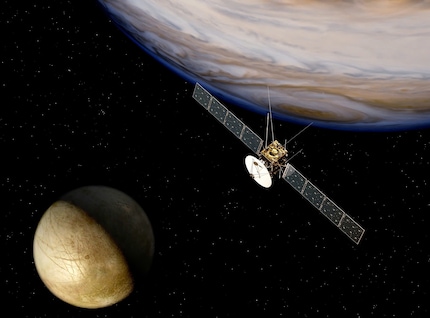
Jupiter's moon Ganymede could detect dark matter
A speculative form of dark matter may have left traces in the largest moon in our solar system. Missions such as Juice could detect them.
For decades, experts have been chasing a ghostly substance that permeates large parts of our universe. Not much is known about this mysterious dark matter, but cosmologists can clearly observe its influence in the movements of star systems and galaxies. Most researchers assume that dark matter consists of tiny, very light particles that hardly interact with their surroundings except through gravity. However, more speculative theories suggest that the substance is composed of many extremely heavy particles that only occur very rarely and have therefore not yet been detected. Evidence of such «macroscopic» dark matter can be found on Jupiter's moon Ganymede, explains physicist William DeRocco in a study that has not yet been peer-reviewed. This would turn the largest moon in our solar system into a gigantic particle detector.
Although dark matter still holds many secrets, experts can estimate its density in the universe based on cosmological observations. If dark matter is very light elementary particles such as sterile neutrinos or axions, they should pass through the Earth in large quantities. Macroscopic dark matter, on the other hand, should only pass through our planet every 10,000 years, according to calculations. This makes detection with a terrestrial detector seem hopeless.

Source: ESA/AOES
However, macroscopic dark matter could leave traces in cosmic objects that can be detected even years later. DeRocco realised that Ganymede would be particularly suitable as an object of study: Jupiter's moon is larger than Mercury and seismically inactive - its icy surface has not changed for more than two billion years. «Due to the different composition of the subsurface layers, material can be released from deep layers when dark matter collides with the moon, which is not possible with conventional impacts», writes the physicist in his employees. The reason for this is the enormous density that macroscopic dark matter should have according to theoretical calculations. Evidence of collisions between Ganymede and the extremely dense substance could be provided by space missions such as Juice or Europa Clipper, which are currently on their way to Jupiter.
Spectrum of Science
We are partners of Spektrum der Wissenschaft and want to make well-founded information more accessible to you. Follow Spektrum der Wissenschaft if you like the articles.
Original article on Spektrum.de
Experts from science and research report on the latest findings in their fields – competent, authentic and comprehensible.
From the latest iPhone to the return of 80s fashion. The editorial team will help you make sense of it all.
Show all